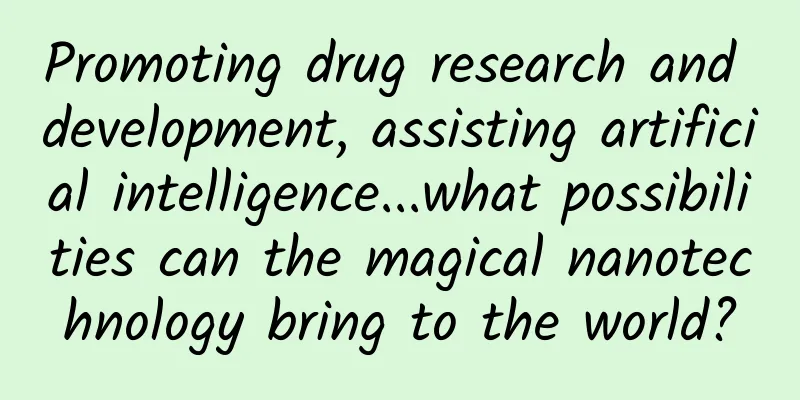Promoting drug research and development, assisting artificial intelligence...what possibilities can the magical nanotechnology bring to the world?

|
In today's world, people are no longer unfamiliar with nano. The tiny nano seems to have opened a door to a strange country, allowing us to step into the magical world of nano. Nanoscience has penetrated into every aspect of our lives, from nano-scale satellites to nano-underwear, etc. Humans have achieved control over the entire microscopic world through continuous exploration and research of the nanoworld. Nanoscience has also spawned nanomaterials, nanomedicine, nanobiology, nanoelectronics, and so on. With nanotechnology, a small electronic device can store more information, allowing drugs to be more accurately targeted in the human body, double the strength of metal materials, make ceramic materials more plastic, and allow nano-integrated devices to fly into the sky with satellites, achieving the magical functions of lightweighting, reducing costs, and increasing efficacy. Let's start with the latest nano research results. One of the 2020 Future Technology Awards is for the research on nanostructured metal materials, which allows metal materials to have high strength, high plasticity and high conductivity at the same time. The grain size of ordinary metal materials ranges from tens to thousands of microns. When the grain size continues to shrink to tens to hundreds of nanometers, the nanometals we often hear about are formed. In the field of traditional materials science, it is often believed that there is a natural contradiction between the strength, plasticity and conductivity of nanometals. However, in the long-term research and observation of nanometals, scientists have found that if the structure of nanometals is modified and adjusted, it is entirely possible for nanometals to combine various properties in one, becoming a magical material that breaks common sense. The research team of the Chinese Academy of Sciences has discovered two new nanostructures, achieving a major breakthrough in the strengthening principle of metal materials. These two structures are high-density nanotwins and gradient nanostructures, which have ultra-high strength and strong electrical conductivity and plastic deformation capabilities. For example, the strength of pure copper samples with gradient nanostructures is twice that of ordinary coarse-grained copper, while the tensile plasticity remains unchanged, which breaks through the inverse relationship of strength and plasticity of the traditional strengthening mechanism, and has been applied in the industry and achieved significant economic benefits. So, what else can humans do at the nano level? The discovery of nano-scale core-shell structure is undoubtedly a major event in the nano world! In the microscopic world, which is very different from the macroscopic world, there is also a material structure similar to Yuanxiao. This "Yuanxiao" is usually only a few dozen nanometers in size, and the shell may be only a few nanometers thick. This is the nano-core-shell structure that has been hot in the fields of materials, chemistry, etc. since the beginning of the new century. Image source: Visual China What is a nano core-shell structure? A nano core-shell structure is generally a nano-scale particle composed of two substances, including a core and a shell. The shape can be spherical, polyhedral, lamellar, or rod-shaped. The nano core-shell structure not only has many magical properties of traditional nanomaterials, but also can obtain better stability and reactivity by regulating the materials, morphology, and design of the core and shell, so as to achieve the replacement of high-cost materials with cheap materials. Nano core-shell structures can save precious metal materials and improve catalytic performance. For example, if a car exhaust catalyst made of platinum metal particles uses platinum metal in large quantities for a long time, its cost will be extremely expensive. However, by using the method of preparing nano core-shell structures, the use of platinum can be limited to the outer shell of the core-shell structure, while the core is made of cheap materials. Since the part with catalytic function is actually only the part of the shell exposed to the outside, the use of cheap material core will basically not affect the function of platinum as a catalyst. On the contrary, if certain special control methods are used in the process of preparing the platinum shell, so that the platinum shell grows a more catalytic form, or exposes platinum atomic faces with stronger catalytic ability, it will be expected to greatly reduce the cost of platinum catalysts while greatly improving the catalytic performance. This is really the biggest thing to do at the lowest cost. Nano core-shell structures can also enhance the stability of core materials. Future new energy vehicles, high-speed rail and other fields are in urgent need of welding materials with high heat resistance, high thermal conductivity and high current flow capacity. Micro-nano copper particles can be sintered at a relatively low temperature, and the porous mesh structure formed afterwards has a melting point similar to that of bulk copper and has extremely strong heat resistance. At the same time, copper is a good conductor of heat and electricity, and has excellent high-temperature properties that far exceed those of traditional solders. Therefore, nano copper will have great potential in the fields of next-generation high-temperature welding materials and advanced conductive pathways. Nano core-shell structures can also be used in the pharmaceutical industry. Compared with the traditional drug preparation process, nano core-shell structures play an important role in maintaining colloidal stability, preventing nanoparticle agglomeration, and controlling particle interface reactions. In the future, nano-level "doctors" will be on duty, and nano drugs will be able to achieve precise positioning and better act on the human body. The wonders of nanotechnology are far more than what is mentioned above. In the future, nanotechnology will affect more disciplines. At present, countries around the world are also making every effort to carry out nanotechnology research. In the future, a large number of nanotechnology products will appear to change human life. We can look forward to the fact that in the near future, humans will meet various nanorobots and say "Hello, new nanoworld"! Highly cross-cutting nanotechnology Nanotechnology is the science and technology of manufacturing materials using single atoms and molecules, and studies the properties and applications of materials with structural sizes ranging from 1 to 100 nanometers. Nanotechnology is a science and technology based on many modern advanced science and technologies. It is the product of the combination of dynamic science (dynamic mechanics) and modern science (chaos physics, intelligent quantum, quantum mechanics, mesoscopic physics, molecular biology) and modern technology (computer technology, microelectronics and scanning tunneling microscopy technology, nuclear analysis technology). Nanotechnology will trigger a series of new science and technologies, such as nanophysics, nanobiology, nanochemistry, nanoelectronics, nanoprocessing technology and nanometrology. |
Recommend
China's telecom technology industry will continue to reshuffle US media: profit sharing will decrease
Reference News reported on January 2 that accordi...
Is spacetime pixelated?
Is space-time pixelated? Just like looking at a d...
When will the 2022 Winter Paralympics start and end? Where exactly will it be held?
In a few days, the 2022 Beijing Paralympic Winter...
2019 OPPO Developer Conference officially opens for public registration
v\:* {behavior:url(#default#VML);} o\:* {behavior...
Pinduoduo’s bargaining logic and strategic marketing methods!
Many people often receive price-cutting links fro...
Analysis of NetEase Cloud’s operational logic!
Let me make a bold prediction. I feel that a new ...
What is the difference between cherries and cherry fruits, which differ in price by 5 times?
Every year when the Spring Festival is approachin...
Testin releases free internal testing tool Pre.im to create a Chinese version of TestFlight
TestFlight, a mobile app beta testing tool favore...
Master these 12 operating methods to help you get rid of the stereotyped activity gameplay
I know that it is not easy to be a content operat...
Why do mobile game companies spend so much money at ChinaJoy?
On the road from Hongqiao Airport to Pudong Inter...
Can eating chili peppers speed up the recovery of oral ulcers?
Recently, some netizens claimed that if you want ...
What overlooked little details on your mobile phone are secretly leaking your privacy?
appendix: References: Source: A scholar The cover...
Why can your activities attract fans but fail to retain them?
The purpose of organizing activities is not to co...
Did the Lifang system affect the people's "freedom to open the door"? Looking at the planning of ancient Chinese cities from the perspective of the Twelve Hours in Chang'an
one Seen from the ancient Tang Chang'an The p...
Gull-wing doors, king chairs, 5C supercharger, Haobo HT creates a luxurious mobile large flat for elite families
Hyper HT, a medium-to-large luxury pure electric ...









